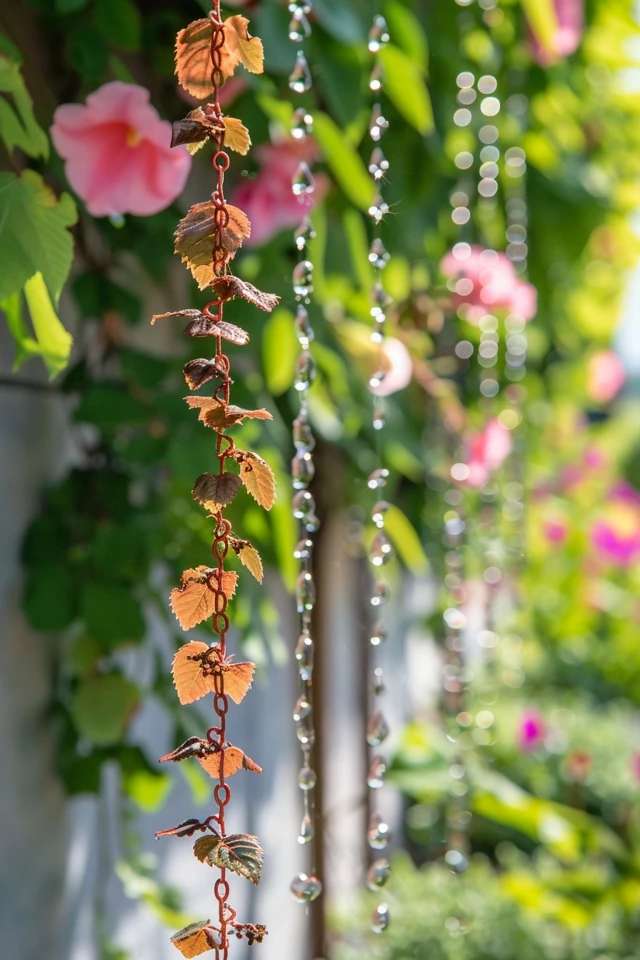Have you ever watched raindrops cascade down from your roof, mesmerized by their graceful dance? I have, and it inspired me to find innovative ways to enhance both the functionality and aesthetics of rainwater drainage in my home. Today, I want to share some creative rain chain drainage ideas that you can implement in your own abode.
When it comes to rain chain installations, the possibilities are truly endless. Instead of settling for conventional downspouts, embrace the beauty of rain chains and let creativity flow. Whether you prefer modern designs or DIY solutions, there’s an option that will suit your taste and elevate your home’s curb appeal.
Key Takeaways:
- Explore unique rain chain designs to enhance the appearance of your home.
- Consider DIY rain chain installation to personalize the drainage system.
- Modern rain chain alternatives offer a sleek and stylish look.
- Anchor the rain chain properly to ensure effective water flow.
- Choose the drainage method that best fits your landscaping and sustainability needs.

Anchoring Points for Proper Rain Chain Drainage
Proper anchoring is crucial for the effective drainage of rain chains. One popular method is to use a hand hammered dish or basin, which provides a secure attachment point for rain chains. By using a hand hammered dish or basin, you can ensure that your rain chain hangs straight and allows water to flow smoothly.
Adding rocks or pebbles in the basin not only prevents it from blowing around in heavy winds but also provides a landing spot for heavy falling water, reducing the splashing and noise associated with rain chains.
Another option for rain chain anchoring is to use anchor stakes and pins, which offer a more minimalist look in landscaping. These anchoring accessories can be easily inserted into the ground and serve as stable attachment points for rain chains. To enhance the aesthetics and functionality, you can incorporate landscaping rocks or stones around the anchor stakes and pins to prevent erosion and provide additional drainage.

Enhancing the Look with Flower Pots and Planters
If you are looking to add a decorative touch to your home’s exterior while anchoring your rain chain, consider directing the water flow into flower pots or planters. This not only ensures proper drainage but also showcases your rain chain in an aesthetically pleasing way. You can choose flower pots or planters in various sizes and designs to complement your home’s style and enhance its overall appeal.
Whether you opt for a hand hammered dish, anchor stakes and pins, or directing the rain chain into flower pots and planters, ensuring proper anchoring is essential for optimal rain chain drainage.
Using a Rain Barrel with Your Rain Chain
A rain barrel is a great addition to your rain chain setup, providing a sustainable solution for collecting rainwater. By collecting rainwater, you can reduce water consumption and promote sustainable gardening practices.
When incorporating a rain barrel with your rain chain, it is important to ensure compatibility between the two. There are two main methods to achieve this:
1. Attaching the Rain Chain to a Top Screen on the Rain Barrel
In this method, the rain chain is connected to a top screen placed on the rain barrel. This allows the water to flow down the rain chain and into the barrel. The top screen helps filter out debris and prevent clogging.
By using this method, you can easily collect rainwater and use it for various gardening purposes, such as watering plants or washing outdoor equipment. It’s a simple and efficient way to utilize rainwater while minimizing water wastage.
2. Removing the Top Screen and Running the Rain Chain Directly into the Barrel
If your rain barrel doesn’t have a top screen or you prefer a direct connection, you can remove the top screen and run the rain chain directly into the barrel. This allows the rainwater to flow freely into the barrel, bypassing any filtration.
When implementing this method, it’s essential to choose a rain chain with a high waterflow index. This ensures that the rainwater flows smoothly and efficiently into the barrel, maximizing its collection capacity.
Remember to position your rain barrel strategically to capture the most rainfall. Ideally, it should be placed in an open area where rainwater runoff from your roof can easily be directed into the barrel through the rain chain.
Using a rain barrel with your rain chain is a practical and eco-friendly solution for collecting rainwater. Not only does it help conserve water, but it also promotes sustainable gardening practices, allowing you to maintain a lush and thriving garden with minimal environmental impact.

Direct Water into an Underground Drain
In addition to the various anchoring methods for rain chains, another effective way to ensure proper drainage is by directing the water into an underground drain. Landscapers and architects often incorporate underground drains as part of the rainwater management system. By installing an underground drain where the downspout would typically end, you can seamlessly integrate your rain chain into the drainage system.
When using an underground drain with a rain chain, it is essential to position the drain directly underneath the area where the rain chain will hang. This alignment allows for optimal water flow and prevents any water pooling or overflow. To connect the rain chain to the underground drain, you can use additional accessory chains or a loop kit, ensuring a secure and functional setup.
Directing water into an underground drain offers several benefits. Firstly, it helps divert rainwater away from your home’s foundation, safeguarding it against potential water damage. Secondly, it promotes proper drainage, preventing water accumulation in your yard or garden. Lastly, integrating your rain chain with an underground drain creates a streamlined and aesthetically pleasing solution for managing rainwater runoff.

